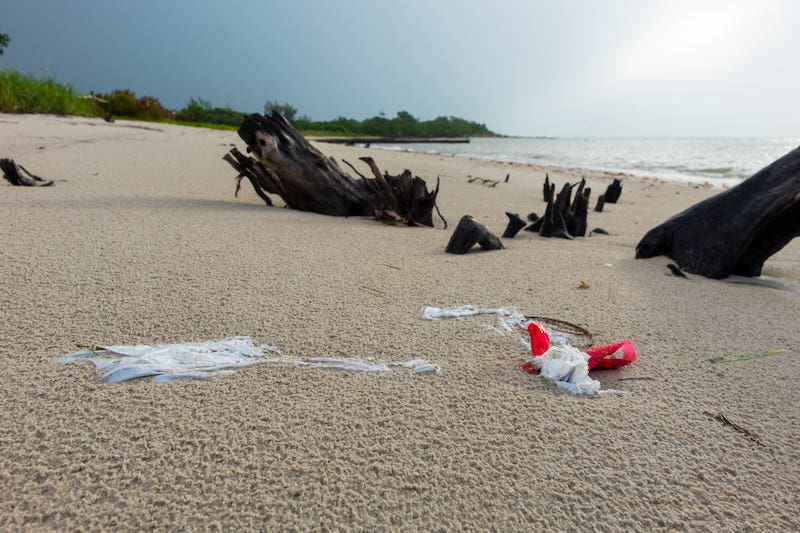Plastic bag bans reduce shoreline litter by nearly 50%, study finds
Plastic debris is now a troubling reality in oceans and along shorelines worldwide. From tiny microplastics to large waste items.

Plastic bag policies effectively reduce shoreline litter, improving marine health and informing global strategies against plastic pollution. (CREDIT: CC BY-SA 4.0)
Plastic debris is now a troubling reality in oceans and along shorelines worldwide. From tiny microplastics to large waste items, plastic pollution threatens marine life, ecosystems, and even local economies. Animals suffer fatal entanglements, digestive system blockages, and toxic chemical exposure.
Communities also face declining tourism and property values, highlighting the urgent need to manage plastic waste effectively. According to global estimates, marine plastic damage costs society over $100 billion annually.
To tackle this problem, countries around the world have enacted policies targeting single-use plastics, especially thin plastic shopping bags, a common pollutant found along shorelines.
More than 100 nations have implemented either bans or fees on these bags, and the United States has a variety of similar state and local regulations. However, understanding how effective these policies are at reducing plastic litter—especially along shorelines—has remained unclear until now.
Tracking Policy Effectiveness
Researchers from the University of Delaware and Columbia University recently completed an extensive study on plastic bag policies. The study, published in the journal Science, explored how bans and fees impacted shoreline plastic litter across the United States. This investigation is groundbreaking, using comprehensive data from thousands of volunteer-led shoreline cleanups recorded through the Ocean Conservancy's Clean Swell app.
“When we found the database with information from different shoreline cleanups, we realized we could see how litter changed after policies were introduced,” explained Kimberly Oremus, associate professor at the University of Delaware’s School of Marine Science and Policy. “Then, we compared these findings to places without any plastic bag policies.”
Anna Papp, an environmental economist and the study’s lead author, emphasized the importance of direct measurement. "Previous studies often relied on sales data from stores. Our research directly observed litter reductions along shorelines," she said.
Related Stories
Strong Evidence from Cleanups
Analyzing over 45,000 shoreline cleanups from January 2016 through December 2023, researchers evaluated 611 different plastic bag policies across U.S. towns, counties, and states. Their findings showed a clear reduction in plastic bag litter—between 25% to 47%—in areas with regulations compared to those without any policies.
These positive impacts intensified over time without signs of reversing. “It’s reassuring to see policies making a measurable difference,” noted Oremus, highlighting that plastic bag litter significantly decreased where regulations existed.
Additionally, the study found that the type and scope of policy mattered. Fees imposed on plastic bags proved somewhat more effective at reducing litter than outright bans. Policies at the state level generally outperformed local regulations, achieving broader and more substantial reductions.
Interestingly, the effectiveness of these regulations was greatest in locations where plastic pollution had previously been most severe. Papp pointed out, “The policies were especially impactful in areas where plastic litter problems were worse to begin with.”
Not a Complete Solution
Despite these encouraging results, the researchers also issued a caution. Although plastic bag policies significantly slowed the increase of shoreline litter, the overall amount of plastic debris continues to rise. Plastic pollution is an escalating global issue, and these measures merely reduce the pace of its growth rather than completely stopping it.
Oremus noted, "We’re still seeing an increase in plastic bags on shorelines overall, but it’s rising slower where these policies exist.” This reality highlights the need for broader solutions and additional policies targeting other single-use plastics to fully address the scope of plastic pollution.
Global Implications
Globally, addressing plastic waste has become a major policy priority. Currently, 175 countries are negotiating an international plastics treaty to establish universal guidelines and standards. Oremus and Papp's study offers critical insights as international leaders prepare for the next negotiation round scheduled for August 2025.
Their findings emphasize the value of robust data-driven policy-making. As global plastic use continues to surge, evidence-based solutions like these will be essential to mitigating the devastating impacts of plastic pollution.
“Our findings demonstrate that plastic bag policies can be broadly effective at reducing shoreline litter,” concluded Papp. “While significant, these benefits underscore the need for comprehensive strategies addressing plastic waste across all sectors.”
Scholars and policymakers alike recognize that reducing plastic bag use is an important step toward healthier oceans and waterways. Continued research and global cooperation will be crucial for effectively tackling this complex environmental crisis.
Note: The article above provided above by The Brighter Side of News.
Like these kind of feel good stories? Get The Brighter Side of News' newsletter.



